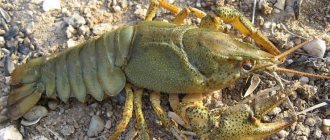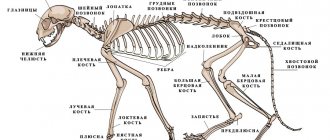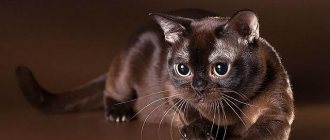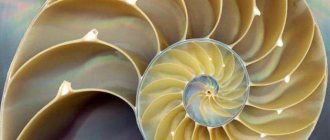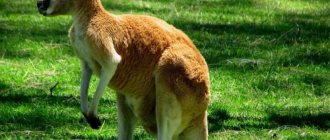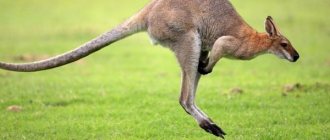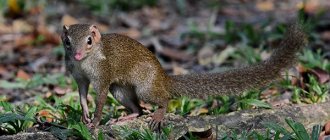Digestive system
The cat's digestive system consists of:
- esophagus;
- stomach;
- small intestine;
- duodenum;
- jejunum;
- liver;
- large intestine.
The esophagus has a hose-like shape of a relatively small size, and connects the animal’s mouth and its stomach. The esophagus originates from the inner base of the mouth, extends through the neck and chest, passes close to the heart, extends through the muscles of the diaphragm, and connects to the stomach. It is important to note that the esophagus is equipped with special muscles that push food into the stomach, producing synchronous movements similar to waves. The esophagus is one of the most difficult organs in terms of surgical treatment, as it is difficult to access and extremely difficult to heal.
The cat's stomach is single-chambered, and is distinguished by the location of the mucous membrane on its inner walls. The cat's stomach is adapted to accommodate a large amount of food, but it is almost never completely filled, since cats are not prone to gluttony (the vast majority). Also, the inner surface of the stomach is dotted with folds, which have an additional mechanical effect on the process of breaking down food. Food processed by gastric juice enters the duodenum through the pyloric sphincter. Most often, eaten food remains in the stomach for about 12 hours.
The small intestine is a tubular organ that connects the stomach and large intestine. Often the length of a cat's small intestine is about 1.5-2 meters, and includes the duodenum, jejunum, and ileum.
The duodenum is small in size and serves to mix food with liver and pancreatic enzymes, which is extremely important for digestion.
The jejunum is the longest part of the small intestine, and its internal walls are dotted with thin hairs, which, when in contact with food that comes into contact with them, penetrate into it and suck out all the useful substances. It is here that the final extraction of all useful substances from food occurs, after which it enters the ileum, and then the large intestine, where it turns into feces.
Sense organs
Through the senses, the animal receives basic information about the world around it. As you know, cats have very sharp eyesight and hearing. They can see even in the dark and are able to hear sounds that humans cannot hear.
A description of the anatomical structure of the organs of vision and hearing is important not only in order to get to know your pet better, but also to recognize the presence of pathological changes and know how to help your pet.
Eyes
Visible part of the eye:
- upper eyelid;
- lower eyelid;
- third eyelid;
- Iris;
- sclera;
- pupil.
Cats have relatively large eyes. Cats have stereoscopic vision. This means that they can perceive size, shape and judge the distance to a certain object. Also, cats can see the world around them not only in front of them, but also from the side. Their eyes are capable of capturing images within a range of 205 degrees around them.
Cats' eyes glow in the dark due to the ability of this organ to accumulate rays that enter the eyes during daylight hours. They cannot see in complete and utter darkness. But even a minimal amount of light entering the room allows them to clearly distinguish objects due to the reflection of light from the surface of objects.
© shutterstock
One of the features of cats' eyes is the presence of a third eyelid. This membrane serves as protection against foreign objects entering the cornea. Usually the third eyelid is not visible. It can be noticed in those moments when the animal has just woken up. If it is visually noticeable all the time, or even covers part of the eye, this is a signal about the presence of some pathology in the body.
Ears
A cat's ears are made up of these parts::
- ear canal;
- eardrum;
- middle ear bone;
- vestibular apparatus;
- snail;
- auditory nerve.
Cats have the ability to perceive sounds over a wide range. The physiology of a cat and the structure of its ear allows it to hear high-frequency sounds that are inaccessible to human hearing. A cat can hear about 100 different sounds, while for a person this number is limited to fifty.
There are about 30 muscles around and on the ears that are responsible for movement in this area. Attentive owners notice the cat's ability to move its ears in different directions.
Cat owners should pay extra attention to the structural features of the ear. Your pet should have its ears checked and cleaned regularly. Due to the rather complex structure of the ear, one can often miss the presence of various inflammatory processes and the presence of ear mites.
Circulatory system
The circulatory system in cats works the same way as in other mammals: the heart pushes blood through arteries that have elastic walls and rhythmically carry out contraction and relaxation movements. It is thanks to such movements that arteries located close to the skin can be felt, and this is called the pulse. The cat's pulse is easiest to detect on the inside of the thigh, and in a healthy animal it should range between 100-150 beats per minute.
The cat's brain absorbs 15-20% of the blood, the muscular system absorbs up to 40% of the total blood, and about 25-30% of the blood goes to the internal organs. During physical activity, muscles can absorb up to 90% of the blood, which is why cats get tired so quickly, but can focus maximum strength for a short period of time.
Respiratory system
The anatomy of a cat is not much different from other mammals. This also applies to the respiratory system. It includes the following organs :
- bronchi;
- larynx;
- lungs.
- nose;
- nasopharynx;
- trachea;
© shutterstock
The breathing process begins from the nose and nasopharynx. The nose has 2 nasal cavities inside, in which, when inhaled, the process of recognizing odors, heating the air and purifying it from impurities, dust, and debris occurs. The cavities are separated by a septum of hyaline cartilage.
The larynx is located between the trachea and pharynx, and is located above the hyoid bone. Basic functions of the larynx :
- air conduction;
- preventing food from entering the respiratory system;
- formation of sounds.
The larynx consists of five movable cartilages and a mucous membrane. It also contains the vocal cords, vocal muscle and glottis. This is where all the sounds that a cat makes are produced.
The purring of cats occurs due to the special location and functioning of the organs of the larynx. Purring occurs without effort on the part of the animal, and has the same rhythm as breathing. In this case, the muscles contract at a frequency of more than 1000 times per minute.
The vocal cords of cats differ in their structure from the vocal cords of other animals. Attentive owners may notice that the pet’s “speech” is not limited to meowing. And even ordinary meowing can be different. It is quite simple to study the “language” of your cat, and you can accurately guess what exactly the pet is telling us. For example, dogs can only make about 10 different sounds. And representatives of some cat breeds can express themselves using about 100 sounds that exist in their “lexicon”.
A healthy animal in a calm state takes about 20-25 breaths per minute. Kittens take breaths and come out more often.
Endocrine system
The endocrine system is primarily responsible for hormones and their production in the corresponding organs. Thus, the cat’s brain produces antidiuretic hormone, oxytocin, corticotropic hormone, adrenocorticotropic hormone, cortisol and growth hormone.
The adrenal glands produce a lot of other hormones, the main purpose of which is to regulate metabolism, and are also responsible for behavioral characteristics. The adrenal glands also produce cortisol, a small portion of testosterone, as well as epinephrine and norepinephrine.
Nervous system
The nervous system of cats is divided into central and peripheral. Each of these systems in a cat performs functions that are standard for most mammals.
The central nervous system consists of the brain, brain stem and the so-called spinal cord. The central nervous system is the most important in the body of any living creature, and simple and complex reactions, as well as some reflexes, depend on it. In addition, the central nervous system interacts with the peripheral and autonomic ones, ensuring their functioning and control.
The peripheral nervous system is responsible for the cat's conscious motor abilities. So, thanks to this system, a cat can move its paws, extend its claws, run, and generally lead the lifestyle that it leads. Also, the peripheral nervous system transmits pain impulses to the central nervous system from any part of the body where peripheral nerve endings are present.
Features of the external structure of cats
On average, the length of an adult cat excluding the tail is 50-60 cm, with the tail - 75-85 cm. Sexual dimorphism is weak - females are only 5-7 cm smaller than males. The height of cats at the withers is 25-28 cm.
The largest cat, according to the Guinness Book of Records, is a Maine Coon from Melbourne named Omar, its length is 121.9 cm.
A pet weighs on average from 2.5 to 6.5 kg, but there are breeds whose representatives are considered real heavyweights. For example, the jungle cat, Siberian cat and Maine Coon can gain weight up to 13 kg.
Head
Cats have an elongated or rounded head. Relative to the entire body, it is small in size. For example, wild relatives like the tiger and lion have a larger muzzle due to a more massive jaw and pronounced fangs.
The surface pattern of a cat's nose is unique, like a human fingerprint.
The cat can rightfully be called a big-eyed animal. And it's not just a matter of keen eyesight. Cats are among the ten animals with the largest eye sizes relative to the size of their muzzle. Thanks to this feature, cats can immediately see a picture with a 200° field of view without moving their head (for comparison, a person’s visual range is only 180°).
Each cat’s ear is controlled by more than 10 muscles, thanks to which cats can change the position of the ears on the head - press them, bend them, turn them towards the sound, etc.
A special feature of the cat is the presence of very sensitive whiskers on its face. These are hard whiskers, which at the base are penetrated by a large number of nerve endings. Under no circumstances should you pull, let alone tear out, these whiskers - this causes pain to the animal.
With the help of whiskers, the cat receives information about everything that surrounds him - about objects, about the weather, approaching enemies and even the temperature of food
Torso
The body of a cat is divided into the back, chest, and abdomen. According to the relationship of the body to the head and paws, cats have three body types:
- Heavy - these cats have a wide body, a large head and rather short but dense legs and tail.
- Lungs - the body is slender and elongated, the head seems miniature in comparison.
- Medium - in this case, there is maximum harmony between the sizes of the body, head and tail. As a rule, outbred animals have an average body type.
Hair coat is of great importance for a cat. There are no wild naked cats (sphynxes are the result of artificial selection, they are not able to survive in nature). Wool protects the animal from cold, direct rays of the sun, and injuries. Miniature muscles located at the roots of the hairs can raise them on end - at such moments, cats seem larger than usual. This is a defense mechanism designed to scare off the enemy.
Cats love to climb higher - their long tail allows them to maintain balance.
Limbs
Some people mistakenly consider only the pads on which the animal steps when walking and running to be a cat's foot. In fact, it is longer and reaches a protuberance that is a vestigial finger (it can be easily felt, since the claw never retracts into it). It turns out that the cat moves “on tiptoe” all the time.
The photo shows that cats have five fingers - 4 on one side of the pad and one, rudimentary, located away from their “comrades”, on the opposite side
Musculoskeletal system
The cat's body has two main types of muscles: smooth muscle and striated muscle. Smooth muscles are found in all the internal organs of the cat, and are directly connected to the autonomic nervous system, thereby ensuring the work and unconscious functioning of the internal organs, an excellent example of which would be the esophagus and the heart.
The striated muscles are attached to the skeleton and provide the cat with physical strength, the ability to move, hunt and fight. The striated muscles are familiar muscles that we can feel on the limbs and body of the pet.
An important part of the musculoskeletal system of a cat are tendons, ligaments and joints, which in all cats are distinguished by strength, flexibility and enviable elasticity until old age.
The cat's shoulder girdle, which has a unique structure, deserves special mention. Thus, in almost all mammals, the bones of the forelegs are connected to the body with the help of the collarbone, but in cats, the bones of the limbs are connected to the body exclusively with the help of muscles, which provides them with incredible mobility.
Skeleton and its parts
What a cat's body consists of can be found out through anatomy - a branch of biology that studies the structure of the body. First, you should get acquainted with the frame that holds all the important organs, that is, with the skeleton.
There are about 40 more bones in the cat skeleton than in the human skeleton, amounting to 244-250 pieces. The exact number depends on the length of the tail.
Skull and teeth
The cat's skull has 24 bones. 13 of them are on the facial part, and 11 are on the cranial part. Compared to other mammals, a cat's head is quite small in relation to its body, but it has a well-developed brain inside its skull.
The strong jaws of mustachioed pets have 30 sharp teeth. A smaller number (26) is typical only for kittens. By 7-8 months, their milk teeth are replaced by molars, and the dentition is replenished with missing molars.
Spine and tail
A cat's flexibility is due to the amazing mobility of its vertebrae. They can all be divided into 5 departments:
- cervical, consisting of the most massive bones;
- thoracic, to which 8 pairs of ribs are attached;
- lumbar, surrounded by muscles that hold the contents of the abdominal cavity;
- sacral, consisting of 3 fused vertebrae;
- caudal, including from 12 to 28 vertebrae.
Thanks to the massiveness of the cervical vertebrae, the animal can easily turn its head almost 180°, and thanks to its underdeveloped collarbones, it can easily penetrate the narrowest crevices.
The tail plays a special role. With its help, the cat maintains balance while jumping or falling from a height.
Four paws, and there are scratches on them
A cat's paw bones are not directly attached to the skeleton. They are held in place by muscles and tendons.
The hind limbs differ from the front limbs in being longer and having fewer fingers. There are as many of them in front as there are in humans, and in the back there are only 4.
Each of the fingers is equipped with a sharp claw. In a calm state, the claws are retracted into a special pouch, but when you press on the pad, they can be returned back. This is very convenient when trimming overgrown claws.
Due to the unusual location of the knee (right under the belly), cats always walk on tiptoe. This bizarre method of transportation is not only silent, but also very safe. When jumping, the paws absorb all the energy expended, so landing from a great height is soft and quiet.
